|
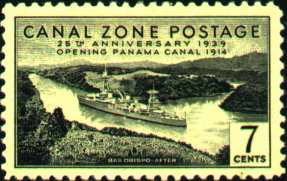
|
Maritime Topics On Stamps :
The Panama Canal!
|
The American cruiser 'Houston', build 1929,
passing Bas Obispo, Panama Canal.
| |
|
Vasco Nunez de Balboa, a Spanish conquistador and discoverer, was the first to cross
the Isthmus of Panama. On the 29th of September, 1513 he reached the Pacific Ocean and called
it 'South Sea'. His discovery refuted Columbus who claimed to have found the seaway to India.
|
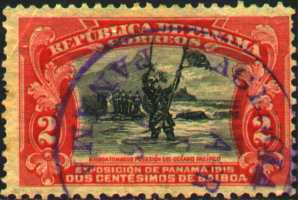
|

|
During the Gold Rush to California, 1849 - 1853, all gold diggers crossed the Isthmus of
Panama by a sea-land-sea voyage. You can see this journey on the beautiful stamps above.
Left: 'Arriving at Chagres on the Atlantic Side' with a brigg and a boat.
Followed by 'Up the Chagres river to Las Cruces' on a raft. The next stamp shows
'Fourty-niners' on the 'Las Cruces Trail to Panama' using horses and donkeys.
To the far right the gold diggers 'Leaving Panama for San Francisco' on the
paddle-steamer 'S.S. Panama', build in 1848 for the 'Pacific Mail' Company.
|
|
In 1879 a geological congress took place in Paris where it was decided to build a canal
bridging Panama at sea level. France agreed on a treaty with Columbia, because in those
times Panama was still Columbian territory.
Two years later the French started the project. Organization and management
was done by the famous Ferdinand de Lesseps, the former constructor of the Suez Canal
(1869), but in 1889 the French Canal Company went bankrupt.
|
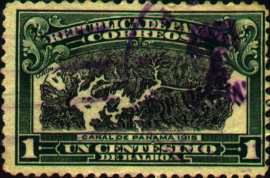
|
The main reasons were:
- Malaria and yellow fever caused 20,000 casualties among the workers
- Construction fumbles and poor planning
- Financial problems
On this stamp you see the canal territory from east to west including lake Gatun.
|
In 1903 the US driven by president Roosevelt took over from France. They tried to buy the strip of
land across the isthmus of Panama but the Columbian senate refused. A revolution of the
regional population greatly helped the US and warships were sent to the Atlantic and
Pacific sides of the area. The presence of these ships prevented Columbian troops to enter
the region and so the new Republic of Panama could be founded. As an expression of gratitude the US
was granted control of a 10 miles wide zone, later called the Panama Canal Zone.
|

|
|
On the stamp to the left you can see president Roosevelt who always believed in a strong navy.
He supported the canal construction as well. To the right you can see George
Washington Goethals, technical leader during the canal construction period from 1907 to
1914. From 1914 to 1916 he rose to governor of the Canal Zone.
|
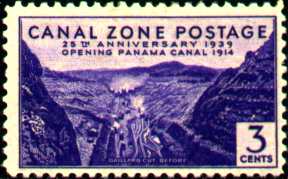
|
Work started anew in 1904 and turned to what became the greatest engineering feat attempted to this date.
The Americans learned from the French mistakes and introduced a program against malaria
and the yellow fever. In 1906 the construction plans were revised to build a high-level lake-and-lock canal
and dam the Chagres river. The Americans even developed special equipment like steam shovels,
drills, track-shifters and dirt spreader.
|
Additionally they build a completely new railroad, three
sets of locks and a huge artificial lake. At some times more than 40,000 people were employed
on the project.
The most difficult task was to find a way through the infamous rocks of Culebra, shown
on the stamp to the left.
|
During the canal contruction period this way was called 'the Culebra Cut', but it was renamed
to 'Gaillard Cut' after. Col. David DuBose Gaillard, the engineer in charge of
this section of the canal work, shortly thereafter.
The Gaillard Cut starts at Gamboa with an average depth of 42 feet and spans 8.5 miles
(13.7 km) up to the Pedro Miguel Locks. The width in those times was 300 feet (91.4m). The 'Cut'
was the result of an eternal struggle of men, machines and explosives against jungle, rocks,
heat and mosquitos.
Passing Gaillard Cut you can see the
SS 'Andrea F. Luckenbach', Luckenbach Line, build 1919 by Bethlehem Steel, 6565 tons.
|
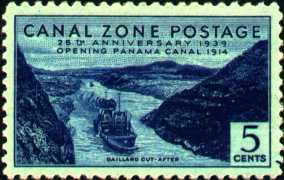
|
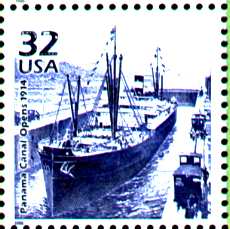
|
The canal was declared open on the 15th of August, 1914. The first ship to
pass the canal was the SS 'Ancon', which you can you see on the stamp to the left.
70,000 people worked fors 10 years in this project. 200 million cubic meters of earth
had been moved (three times more than at Suez) to clear the way, the costs skyrocketed
to $400 million and 5,600 deaths were mourned!
The 'Ancon' was build in 1902 by Maryland Steel, 9332 tons. In 1908 she was bought by
the Panama Canal Company.
|
|
When entering the canal from the Atlantic side you will pass through the Gatun locks you
can see on this stamp.
They are a series of 3 locks that raise the ship 85 feet (26m) to the artificial Lake Gatun.
After passing the Gaillard Cut there is the Pedro Miguel Lock, a single lock, which lowers
ships 31 feet (9.4m) to another small lake. At the Pacific side we have the Miraflores
locks, which lower the ships 54 feet (16m) using two steps to the sea level.
|
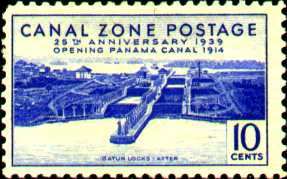
| |
All locks are
a 1000 feet (300m) long, 110 feet (33m) wide and 41 feet (12.5m) deep. The locks come
in pairs, so that ships may simultaneously pass in opposite directions.
|
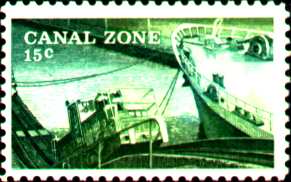
|
Only small craft are allowed to pass through the locks using their own power. Large craft
are towed by electric trains, which operate on cog-tracks on the lock walls.
6 trains are usually used for a vessel, 3 on each side for the bow, stern and midship points.
|
|
The Panama Canal has a length of 51 miles (82km). The passage takes 8 to 10 hours
and must be done with pilot support and Panamese mooring people on the ships.
The canal shortens the seaway round Cape Horn by 8000 nautical miles (15,000km).
|
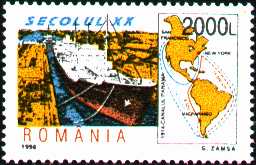
|
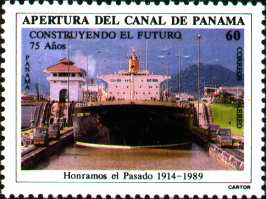
|
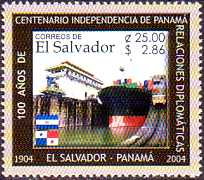
|
As we can see on these stamps above, the dimensions of the locks decide about the size of ships
which can pass the canal.
The maximum dimensions allowed for regular transfer are:
- Beam 106 feet (32.3m)
- Length 965 feet (294.1m)
- Draft 39.5 feet (12.1m)
- Height 190 feet (57.9m) from the waterline to the highest point.
These dimensions are called the 'Panmax Class'.
|
Some statistical data regarding canal traffic:
- 1916: 807 passages
- 1970: 15,523 passages
- 1998: 13,137 passages with 192 million longtons
On the 29th of February 1968, the canal was passed by a record-setting 65 ships.
From 1914 up to today over 800,000 passages were made.
On the stamp you can see the Pedro Miguel locks.
|
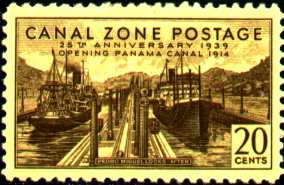
|
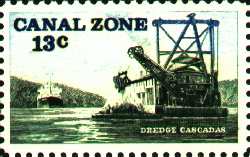
|
The first major improvement was the construction of the Madden Dam to regulate the
Chagres river, completed in 1935. The widening of the Gaillard Cut from
300 to 500 feet (91.4 to 152.4m) was finished in 1969. This allowed unrestricted
two-way traffic for the majority of the ships using the canal. In 1974 the channel was
deepened to a constant draft of 39.5 feet.
|
|
In 1977 the US signed a new treaty with Panama giving partial control to Panama from
1979 up to the year 2000.
On the right stamp you can see US president Carter and Panamese O. Torrijos who were
responsible for this treaty. During 1999 the US left the Canal Zone and gave full
control to Panama on the 1st of January, 2000.
However there are still troops remaining to guarantee peace and safety.
|
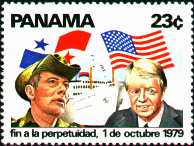
|
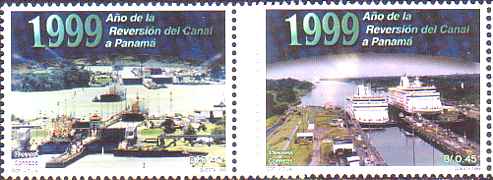
| |
In October 2006 the inhabitants of Panama decide in a voting for an extension of the canal.
The great container ships cannot pass the canal. Great new locks will be build beside the old ones
and they will use reutilized water. (Today we have a loss of 200,000 cubicmeter water of the Gatun Lake
during every ship passage). The canal entry will be widened. The shipping channel in the Gatun Lake and the
Gaillard Cut will be excavated. The extension started in 2007 in September and the completion should be in 2014.
|
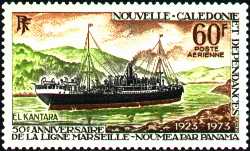
|
Here you can see the general cargo steamer 'El Kantara', build in 1905 for
French Messageries Maritimes, on its way to the Pacific Ocean.
You can find stamps of the Panama Canal first of all from the Republic of Panama and the Panama Canal Zone,
the United States, Columbia, Romania, El Salvador and New Caledonia.
There are many stamps about Suez, Kiel Canal, Wolga-Don Canal, Canal of Korinth,
the Great Lakes Seaway etc. It is possible to assemble a very interesting 'Canal collection'.
|
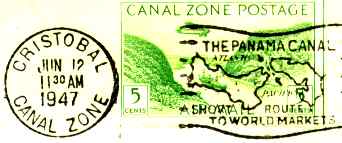
|
|